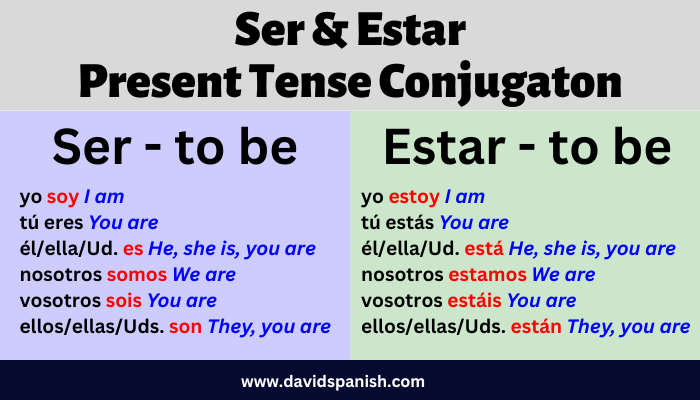What is the difference between ser and estar in Spanish?
In Spanish, the verbs ser and estar both mean “to be”. The verb ser is used to describe permanent situations and estar is used to describe temporary situations. For example, “Soy mexicano” (I am Mexican) and “Estoy en España” (I’m in Spain). This post will explore ser vs. estar in detail with examples.

Ser vs. estar in Spanish: Explanation for beginners
Understanding the difference between ser and estar is one of the biggest challenges for all students learning Spanish, even at the advanced level.
Rather than trying to memorize all of the rules on this page at once, try to simply get a sense of the permanent vs. impermanent nature of the sentences.
As time goes by, you’ll gradually develop a sense for which verb to pick. When in doubt, you can also simply ask a Spanish speaker, “¿Ser o estar?” (ser or estar?).
Both ser and estar are irregular verbs. This means that their conjugations in the present tense are different from other regular -ar and -er verbs.
Before we look at their usages with example sentences, let’s take quick look at the two verbs in the present tense.

When to use ser
In general, use ser to describe what something or someone is or is not. These are qualities that do not change over time. For example, “I am tall” or “She is intelligent”.
Identity of a person
- Yo soy David. I am David.
- Tu eres Juan. You are Juan.
- María es mi novia. Maria is my girfriend.
- Juan es su esposo. Juan is your husband.
Identity of an event
- Hoy es mi cumpleaños. Today is my birthday.
- Manana es Navidad. Tomorrow is Christmas.
Identity of a thing
- Éste es el edificio. This is the building.
- Ésta es la calle. This is the street.
Appearances and personalities
- Ella es alta. She is tall.
- Él es generoso. He is generous.
Professions and religions and nationalities
- Ella es dentista. She is a dentist.
- Él es cristiano. He’s Christian.
- Jorge es mexicano. Jorge is Mexican

Personal relationships
- Diana es la novia de Martín. Diana is Martin’s girlfriend.
- Pablo es el hermano de Daniela. Pablo is Daniela’s girlfriend.
Possession
- El carro es de Alejandro. It’s Alejandro’s car.
- La casa es de Alba. It’s Alba’s house.
Materials of objects
- El collar es de oro. The necklace is made of gold.
- La casa es de madera. The house is made of wood.
Country origin
- Los dulces son de Mexico. The candy is from Mexico.
- El cuadro es de Argentina. The painting is from Argentina.
Telling time
- ¿Que hora es? What time is it?
- Son las tres. It’s three o’clock.
Prices
- ¿Cuanto es? How much does it cost?
- Son cien pesos. It costs one hundred pesos.
Impersonal “it is” expressions
- Es importante hablar espanol en España. It’s important to speak Spanish in Spain.
When to use estar
Use estar to express how something or somebody is or is not. These are temporary “states” that can change at any moment. For example, “I am in a hurry”. Remember, the states described estar are subject to change.
Feelings, moods
- Hoy estoy feliz. I am happy today.
- ¿Por qué Estás triste? You are sad.
- Estás loco! You’re crazy!
Asking somebody how they’re doing
- ¿Como estás? How are you?
- Estoy bien, gracias. I’m fine, thank you.
Location
For location, use estar whether this situation is temporary or permanent. Do not use ser for location.
- Ella está en la playa. She’s at the beach.
- Julia está en Madrid. Julia is in Madrid.
- El estado de Texas está al norte de Mexico. The state of Texas is north of Mexico.

Temporary physical conditions
- Hombre, estas palido. Buddy, you look pale.
- Estoy embarazada. I am pregnant.
Temporary situations using the preposition de
- Alejandro es maestro pero ahora está de cantante en una cantina. Alejandro is a teacher but he’s a singer in a bar.
Weather
- Está soleado. It’s sunny out.
- Está nublado. It’s cloudy out.
Actions in progress
- Yo estoy cantando. I am singing.
- Nosotros cocinando. We are cooking.
- ¿Qué estás haciendo? What are you doing?
There are many situations where the difference between ser and estar is very subtle. Here’s an example:
- Lupita es muy bonta. Lupita is very pretty.
- Lupita esté muy bonita esta noche. Lupita is very pretty tonight.
The difference between the two is that in the first sentence, the situation is fixed or permanent. Lupita is a beautiful woman.
In the second sentence, however, it’s suggested that Lupita appears particularly pretty today.
Here’s another example of a sentence using both ser and estar.
- El helado es delicioso. Ice cream is delicious.
- El delicioso esta delicioso. The ice cream is delicious.
The difference here is very subtle. The first sentence that in general is suggesting that ice cream is delicious.
The second sentence is expressing that “this specific ice cream” right here that I’m eating now is delicious.
Conclusion – ser vs. estar
Understanding ser vs. estar is very difficult but essential for speaking Spanish. Generally speaking, you must figure out if what you’re describing is permanent (use ser) or changing (uses estar).
One tip is to simply be aware of which verb is being used. When you’re reading Spanish or listening, make a mental note of which verb you’re hearing and try to analyze the sentence.
This page on baselang.com does a wonderful job providing example sentences and explanations for each example.
Discover more:
- La Bamba Meaning, Spanish Lyrics & English Translation - May 4, 2024
- Bésame Mucho Meaning, Spanish Lyrics & English Translation - May 3, 2024
- Querida – Lyrics, Meaning & Translation - May 2, 2024
